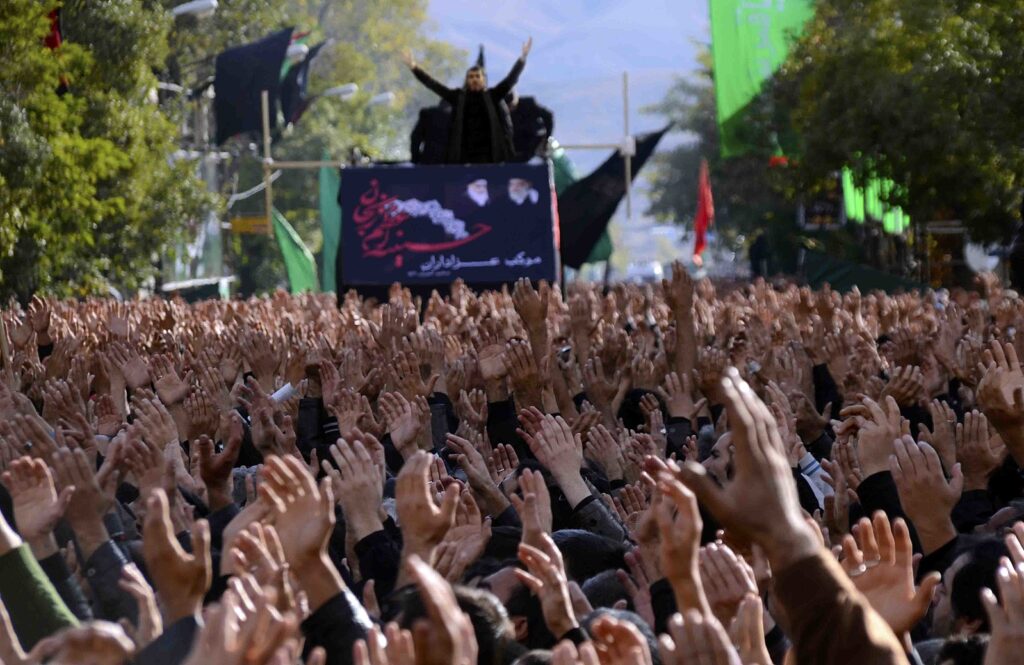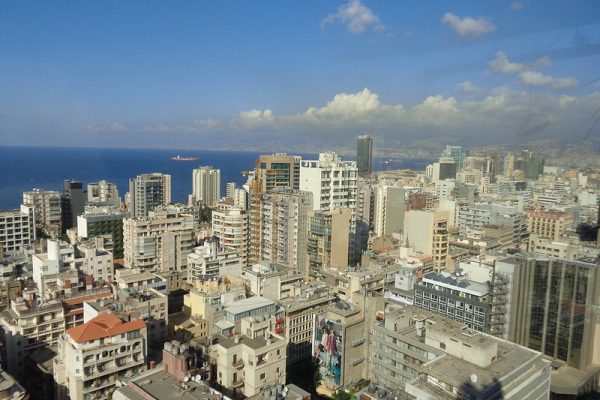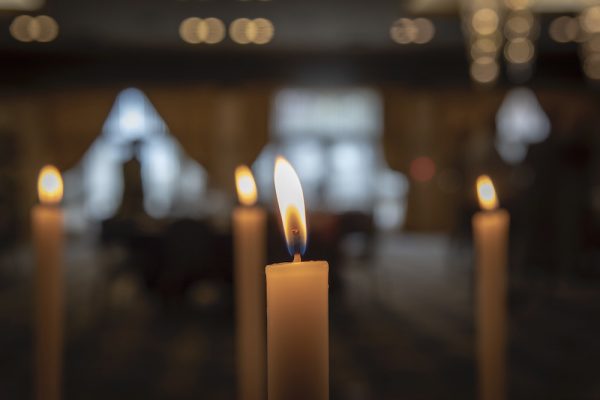Ms. Qarani, a tall woman with autumn-colored wavy hair and steady eyes, marches around holding a box of surgical masks. “Throw your veil in front of your face when you take off your mask to cry!” she orders. She yells at another group of women: “Distance! Distance!” She opens up her arms to show them how far apart they must be. There’s hardly any room though. The women minutely separate and then ripple back together as she moves away.
How would the collective expression of grief be altered by pandemic?
I am in a park in Tehran, Iran, at summer’s end, as the heat settles and the late afternoon light sieves through the weeping willows. We, a procession of women mourners, have gathered here to observe a ritual of lament, Ashura, in the age of COVID-19.
• • •
Shi’a Muslims observe Ashura during the first ten days of the Islamic calendar. The festival mourns the martyrdom of Hussein Ibn Ali, grandson of Prophet Muhammad. Hussein and his followers, mostly family, were en route from Mecca to Kufa in the Arabian Peninsula when they were ambushed by the army of the caliph Yazid ibn Mu'awiya. Hussein was presented with a blunt choice: swearing allegiance to the caliph or death. He did not want a confrontation, but he would not give his consent to what he perceived as illegitimate rule. He and his assembly were stranded for days with no way forward or back. On the tenth morning, as Hussein went to fetch water, he was wounded by an arrow in his cheek. Within hours his limbs were cut off and he was stabbed and decapitated in a short, swift clash known as the Battle of Karbala. The men in his assembly were killed and the women were taken as prisoners of war, sent, with Hussein’s head, to the caliph in Damascus. Hussein is called Hussein-e Qarib (Hussein the alien) because his dismembered body became as placeless as his survivors.
Hussein confided in his sister, Zaynab bint Ali, and the song culture of Ashura honors her agony. By grieving with Zeynab, we not only glorify Hussein’s martyrdom, but also relive it as embodied suffering. For ten days, we recall Zeynab’s dread through ritual acts of mourning (matam) that include singing, weeping, crying, moaning, and chest beating.
Lament traditions force participants to honor common grief. At no other time in my life have I felt such a need to mourn as a community, a city, and a nation.
Inside special ritual tents constructed for Ashura, congregations dressed in black honor Hussein and Zeynab by performing rozeh, lament songs, and nowhe, rhythmic marching music to which mourners perform chest beating. We rekindle our connection to an old world where grief was not a condition to be treated but a state of being to be experienced and honored collectively. The ritual culminates at noon on the last day of Ashura, when Hussein was martyred. Later, at night, people remember when Zeynab and the other survivors began their journey as prisoners and refugees.
While women participate in the ceremonies with men and listen to them perform, women only sing laments for other women within confined spaces. At women’s rozeh, bodies are pressed together, their borders indistinguishable, as women weep and wail and sing. The scents of body odor, rose water, and babies swirl with the hum of women’s chatter.
As Ashura approached this year it would demonstrate how the collective expression of grief would be altered by a pandemic. The contagion has intensified death and suffering while exposing bodies, the source of comfort through ritual, as a spreader of disease. For Iran it also would be a test of the adaptability of religious rule to the needs of governance. In the weeks leading up to the festivities, prominent Iranian religious leaders ordered mourning assemblies to follow guidelines issued by Iran’s the Coronavirus Task Force, a body composed of Health Ministry deputies, cabinet ministers, and various other media and military officials. Only twenty-four hours before the first day of Ashura, the task force ordered indoor assemblies and festival kitchens closed. Overnight, theme parks and football stadiums were transformed to impromptu Ashura venues. Ashura kiosks that once gave out tea or rose water lemonade now distributed packets of hand sanitizer and masks.
At first, it seemed that these regulations would mean the end of gatherings for women, since they require specialized enclosures. But then Tehran’s municipal government announced that women’s religious assemblies could sign up for space in Tehran’s women-only parks, where women can appear without veils and sing.
To take part in a women’s rozeh on the fifth of Ashura, I headed to South Tehran’s Narges Park in the neighborhood of Yaft Abad. A working-class district, Yaft Abad perches on the very edge of the city middle-class Tehranis know; beyond it lies a terra incognita known only to the city’s poorest. I took a cab from Azadi Square, a central bus terminal that distributes laborers throughout the city. As my car entered Tehran’s south, the streets became narrower. People weren’t wearing masks—they probably couldn’t afford them. Eventually I got out and started walking.
• • •
I notice black posters with condolence messages announcing the deaths of neighbors: “Him, him, and him are due to corona,” a shopkeeper tells me. Death is palpable here. There are open signs of piety, including black flags of Ashura, above house doors at a rate not seen in the rest of the city. A massive corrugated metal wall on the very outskirts of Yaft Abad alerts me to the women’s park. I head in through the gates. Inside, there are only other women, including gardeners in yellow and green uniforms.
U.S. policymakers mean to cause Iran pain, and it is among Tehran’s wage workers that the wounds are most visible. The poor have borne the brunt of disease and a crippled economy at once.
The noisy city gives way to a tranquil garden. Narrow walking paths are lined with sycamores and rose bushes. I follow the sounds of beating drums and the black flags on high wooden poles. Mourning groups are spread throughout the park. Each has sealed itself off from the rest of the park by wrapping thick black canvas around the trees near it, creating a communal area with carpets and blankets cushioning the ground. I stop and listen to the performances for a few moments before deciding to join a group called the Assembly of the Lovers of Zeynab.
I sit on a chair in the shade of a jasmine. The organizers, led by Ms. Qarani, are sweeping the carpets. Someone sprays the crowd with rose water which carries a hint of disinfectant alcohol. It makes the air smell like flowers in a hospital. I look around vigilantly to make sure no one comes close. A woman with sad, pistachio-green eyes sits less than three feet away from me on the carpet. Ms. Qarani instructs her to put her shoes, ripped at the toes and heels, in a plastic bag. To my dismay, she puts down her stained silk mask whenever Ms. Qarani walks away. I’m irritated by her but try to distract myself. The lament performer, Ms. Ahmadi, walks to the podium and everyone stands in respect. She begins: “This year we feel Zeynab’s angst more than ever: to not hold your loved one as they are dying, to not have a grave to cry on, to feel thirst and hunger. So cry ladies, cry for Zeynab and for yourselves!” In the first rozeh she performs, Zeynab speaks to Hussein:
Your body will soon be shredded like the wings of a butterfly,And I shall become an alien with no place except upon your ashes.
Like wind begins to rattle leaves in an orchard, the song pulls slow whimpers from the crowd that get louder and louder. The green-eyed woman next to me pulls her black chador, her long black veil, in front of her face and curls up within herself like a turtle hiding in its shell. She begins to cry. I see her torso tremble up and down as she rocks herself slowly. I hear her sob. A fly lands on her foot, the only part of her that is unmoving. I want to reach out and shoo it away, give her comfort. Who has she lost? Will she endure the months to come? I feel pressure in my chest, like an apple is lodged there, and I begin to cry with her. The wailing comes to us as it comes to our neighbor, flowing between our bodies.
Lament traditions force participants to acknowledge and honor common grief. And at no other time in my life have I felt such a need to sit and mourn the events that have come to us as a community, a city, and a nation. Under the maximum pressure sanctions levied against Iran at the direction of the United States, I have watched this city decimated well before it was hit by disease, like a body slowly and painfully being dismembered by the whimsy of a caliph.
The aim of the sanctions is to crush Iran by breaking off every last source of revenue. It started with oil, Iran’s primary source of income, and has gone further to include all industries, banks, and financial lifelines. U.S. policymakers mean to cause Iran “pain,” and it is here, among Tehran’s working class and wage workers, that the wounds are most visible. Due to the embargoes, manufacturing, mining, and industrial plants have closed. Factories have permanently stopped production. Millions of people have been forced down into poverty. A day laborer, if still employed, earns half what they did a year ago. Families are struggling to pay for food as inflation skyrockets and a deep protracted recession uproots lives. A cancer diagnosis means death because the government can no longer afford free health care and chemo drugs are often only found at soaring prices on the black market. Fruit sellers in this neighborhood have a discounted aisle of rotted fruit, ones they used to throw away. The butcher says there is more demand for chicken gizzards and feet than he can meet, as it’s the only protein people can afford. Hunger and poverty are on display in a way I have never seen.
Then the pandemic dealt another blow to people barely able to sustain themselves. The United States piled on more sanctions, as a virus and an embargo raced to devastate Iranian bodies. More jobs disappeared. Family breadwinners died. The poor have borne the brunt of disease and a crippled economy at once. Sanctions are often compared to siege warfare, and now the people under siege have also been ravaged by disease. Times have become so hard that wartime, the Iran–Iraq War of 1980 to 1988, is nostalgically remembered. “At least back then, we were all together,” I’ve heard women say. “Now we have to suffer alone.” In war, families sought shelter together. Now, shelter means distance. Can Ashura help us seek comfort in a (socially distanced) collective? Can our rituals adapt to the shape of our despair?
With Ms. Qarani’s guidance, the women have formed the lines for chest beating. Those on the carpets stand on their knees facing each other. A falling army is honoring and grieving its commander. The women chant, “Oh weeping Zeynab.”
We cross our arms, hit our chests, hold out our arms to the sky, anticipating the blows of the war that will parallel those on Zeynab’s body, and then we bring our hands down to our chests again. We become one. My cheekbones sting as tears build up under my surgical mask. My throat and chest burn. I weep. I want to scream and explode. I am a ball of fire and a melancholy moon. I hit my chest harder. For a moment, our bodies are instruments disrupting the dread and gloom of our isolation, the tide of our camaraderie overcoming the pandemic.
• • •
I walk out of the procession with swollen eyes and a sense of lightness. I thank Ms. Qarani. She hands me bottled water and packaged orange cake; I feel nostalgic for the traditional halva and cardamom tea, usually shared during breaks between songs. Globally, grieving together almost always involves taking comfort in the sharing of food. Of course, this too has to adapt to the pandemic, but the parting gift of water and packaged cake, though well intentioned, felt like it missed the critical communal aspect, not to mention the nostalgic flavors.
Sustenance, like grief, can be felt from a distance.
Back home, my mother tells me that distant family friends, the Shirazis, are cooking a thick ritual stew, awsh, in their backyard. I jump at the chance to join them and see how the foods of Ashura have to adjust to times of COVID-19. When I arrive at the Shirazi’s front yard, a massive copper pot sits on the fire. It is big enough to hold a bear. I admire its hand-hammered patterns that give it the aura of a beautiful ring. Taqi Shirazi, the eldest brother, is the head chef. He is lanky and bald on the top, with flying curls shooting out from the sides of his head. He says that he was going to forego the ceremony this year, but he got too many calls from friends who wanted to come and help, who told him he couldn’t not do it, they relied on the barkat, the spiritual prosperity, that it gave them.
The men started sautéing onions and pounding lamb with large wooden pestles at 1 a.m. They are preparing a meal for 500, using over 150 kilograms of ingredients. For seasoning they will add ginger, cardamom, and cinnamon. The meal will be ready at dawn tomorrow. The sun is setting as I wait for my turn to stir the pot. We are offered ice cream bars. The icy smooth vanilla and delicate sugary chocolate invigorates and cools.
With Mr. Shirazi’s fourteen-year-old nephew, our turn comes to take up our stations at the sides of the pot. We take hold of spatulas the size of shovels and say, “Bismillah” (in the name of God). We are wearing masks, but I can make out freckles on the nephew’s chubby cheekbones. We slowly stir the awsh to make sure the thick stew does not burn on the bottom. Each ingredient has to “melt into the totality,” Taqi said. We each focus on the half nearest us, tracing infinity patterns. There’s sweat hanging from our foreheads as the near-boiling awsh steams our faces. Tomorrow it will provide nourishment to a large group of people, most of whom I will never know. Sustenance, like grief, can be felt from a distance.










